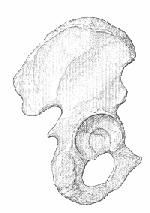 - Discussion
- Discussion- roof arc concept (Matta, et al (1986)), and was based on analysis of 204 acetabular fractures with avg 3.7 year follow up;
- helps determine the amount of intact acetabular dome;
- is a useful method for determining need for surgery, however, it is less predictive for two column injuries & posterior wall frx;
- radiographs need to be taken w/ the patient out of traction;
- Measurement:
- these are made on AP, obturator and iliac oblique views;
- vertical line is drawn to the geometric center of the acetabulum;
- another line is drawn through point where frx line intersects acetabulum & again to geometric center of the acetabulum;
- angle drawn in this way represents medial, anterior, or posterior roof arc as seen on AP, obturator oblique, or iliac views, respectively;
- medial roof arc:
- AP view;
- verticle line is drawn from roof of acetabulum to geometric center of the femoral head;
- second line is drawn from fracture to the geometric center;
- angle subtended by these lines forms the medial roof arc;
- this measurement applies to transverse acetabular fractures and if less than 45 deg, frx is unstable and requires ORIF;
- anterior roof arc:
- obturator oblique view
- this measurement applies to anterior column fractures and if the roof arc is less than 25 deg, then the frx is unstable and requires fixation;
- posterior roof arc:
- iliac oblique view
- this measurement applies to posterior column fractures and if less than 70 deg, then the frx is unstable and requires fixation
Fractures of the acetabulum. A retrospective analysis.

